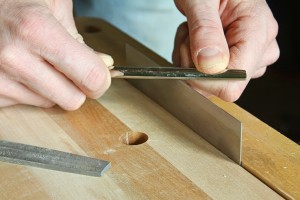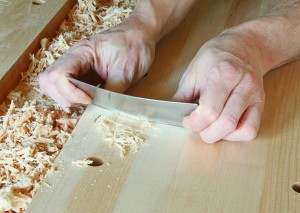 Last summer, we moved to Virginia. Along with packing and loading the personal effects of a family of four, I also had a barn full of woodworking stuff that needed to travel. If you’ve ever moved the entire contents of your shop, your back probably remembers the kind of “heavy lifting” that goes along with it. I might just as well have dismantled, boxed and transported a Sherman tank.
Last summer, we moved to Virginia. Along with packing and loading the personal effects of a family of four, I also had a barn full of woodworking stuff that needed to travel. If you’ve ever moved the entire contents of your shop, your back probably remembers the kind of “heavy lifting” that goes along with it. I might just as well have dismantled, boxed and transported a Sherman tank.
Thankfully, the shop traveled some 400 miles without calamity, and I lost very little skin moving it from Point A to Point B. But one item did take a bit of a beating: my workbench. I’m still not entirely sure what gouged the surface of it, but something somewhere along the way took a 2-ft. skid across the top and peeled off about a sixteenth-inch-deep scrape. I guess that’s what happens when a workbench becomes a shelf for all sorts of goods inside of a shipping container. If this “road rash” had happened anywhere else but on the top, I would have left it alone and called it character. But that gouge was going to bug me. Last week, I set out to make things right again.
I don’t have a jointer plane, so I started out with a low-angle smoothing plane to remove most of the damage and flatten the entire benchtop. Then, I switched to a scraper to finish the job. Even my sharp smoothing plane left areas of tearout here and there where the beech’s grain direction reversed course.
It’s been a while since I’ve worked up a sweat with a scraper, but there’s something really satisfying about it. Cleaning up that surface was an excellent chance to get back to basics with one of woodworking’s simplest tools: a springy piece of steel.
Some people don’t like to sharpen scrapers, but I do. I really enjoy filing and honing the edges and faces flat, then rolling over those fresh new burrs. It’s fun to see a glint of light appear where that tiny hook emerges, then feel it snag your fingernail. Without the snag, you know the burnishing isn’t done.
 I also appreciate that tired feeling that develops in your hands after flexing the blade for an hour or two. It’s not an ache or a cramp but just the strain that comes from muscles put to good use. Then there’s that intense heat that builds up in the steel in quick waves, almost burning your fingertips, but not quite. Odd as it sounds, even that’s a welcomed part of the scraping process for me. But of course those wispy light shavings that peel away are proof positive that a scraper is on the right track, and so am I. Lean into it, tip the blade, feel the burr connect with the wood and push hard. Repeat, over and over again. No machine noise, no sawdust, no worries. Simple but effective. It also affords you a nice chance to connect with your thoughts.
I also appreciate that tired feeling that develops in your hands after flexing the blade for an hour or two. It’s not an ache or a cramp but just the strain that comes from muscles put to good use. Then there’s that intense heat that builds up in the steel in quick waves, almost burning your fingertips, but not quite. Odd as it sounds, even that’s a welcomed part of the scraping process for me. But of course those wispy light shavings that peel away are proof positive that a scraper is on the right track, and so am I. Lean into it, tip the blade, feel the burr connect with the wood and push hard. Repeat, over and over again. No machine noise, no sawdust, no worries. Simple but effective. It also affords you a nice chance to connect with your thoughts.
It really didn’t take long to make that gouge disappear, and I’m glad to check the job off my list of shop chores. Nice to get the bench cleaned up again, but the experience was just as beneficial for me. It was a good afternoon made better with one of the smallest, least obtrusive tools I’ll ever put in a moving box.
Catch you in the shop,
Chris Marshall, Field Editor







